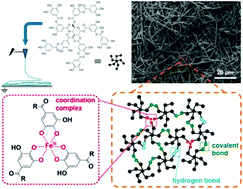Our official English website, www.x-mol.net, welcomes your feedback! (Note: you will need to create a separate account there.)
Polymer-free electrospinning of tannic acid and cross-linking in water for hybrid supramolecular nanofibres†
Nanoscale ( IF 6.7 ) Pub Date : 2018-04-12 00:00:00 , DOI: 10.1039/c8nr01067f Manon Allais 1, 2, 3, 4, 5 , Domitille Mailley 5, 6, 7, 8, 9 , Pascal Hébraud 4, 5, 8, 10, 11 , Dris Ihiawakrim 4, 5, 8, 10, 11 , Vincent Ball 1, 2, 3, 4, 5 , Florent Meyer 1, 2, 3, 4, 5 , Anne Hébraud 5, 6, 7, 8, 9 , Guy Schlatter 5, 6, 7, 8, 9
Nanoscale ( IF 6.7 ) Pub Date : 2018-04-12 00:00:00 , DOI: 10.1039/c8nr01067f Manon Allais 1, 2, 3, 4, 5 , Domitille Mailley 5, 6, 7, 8, 9 , Pascal Hébraud 4, 5, 8, 10, 11 , Dris Ihiawakrim 4, 5, 8, 10, 11 , Vincent Ball 1, 2, 3, 4, 5 , Florent Meyer 1, 2, 3, 4, 5 , Anne Hébraud 5, 6, 7, 8, 9 , Guy Schlatter 5, 6, 7, 8, 9
Affiliation

|
Electrospinning is the process of choice allowing the preparation of nanofibrous materials from a solution usually based on a high molar mass polymer. The solution must bring enough chain entanglements to avoid any breaking or Rayleigh instability of the electrospun jet resulting thus in the deposition of a continuous and regular solid nanofibre. It has been however shown that some few non-polymeric molecules can be electrospun without using a carrier polymer. We demonstrate here the case of tannic acid. Indeed, it was possible to electrospin this molecule solubilised in a mixture of water and ethanol as well as in pure water. Rheology, dynamic light scattering and cryo-TEM highlight the formation of tannic acid aggregates in solution. Above a critical concentration, these aggregates form a supramolecular interconnected network strong enough to allow the electrospinning of a continuous and regular nanofibre. The resulting nanoweb is mechanically stable and can be handled and wrapped. Furthermore, as opposed to the other small molecules for which polymer-free electrospinning was also demonstrated, tannic acid nanowebs can be efficiently cross-linked in water either by oxidative reaction with sodium periodate or, most interestingly, with FeIII by a combination of oxidative reaction and the formation of coordination complexes. The proposed electrospinning and cross-linking strategy is easy, of low cost, and scalable and uses non-toxic solvents as well as biocompatible and biofunctional molecules. Furthermore, thanks to the chelation capacity of tannic acid having the ability to coordinate with a wide variety of metals, hybrid smart nanowebs can be envisaged for diverse applications such as biomedical, catalysis as well as environment.
中文翻译:

单宁酸的无聚合物静电纺丝和水中交联的杂化超分子纳米纤维†
电纺丝是选择的过程,其允许从通常基于高摩尔质量的聚合物的溶液制备纳米纤维材料。该溶液必须带来足够的链缠结,以避免电纺丝射流的任何破裂或瑞利不稳定性,从而导致连续而规则的固体纳米纤维的沉积。然而,已经表明,可以在不使用载体聚合物的情况下将一些非聚合物分子进行电纺。我们在这里演示单宁酸的情况。实际上,可以静电纺丝溶解在水和乙醇的混合物以及纯水中的分子。流变学,动态光散射和cryo-TEM突出了溶液中单宁酸聚集体的形成。超过临界浓度,这些聚集体形成超分子互连网络,其强度足以允许对连续且规则的纳米纤维进行电纺。所得的纳米纤维网在机械上是稳定的,并且可以被处理和包裹。此外,与其他也证明了无聚合物静电纺丝的小分子相反,单宁酸纳米纤维网可以通过与高碘酸钠或最有趣的是与铁的氧化反应在水中高效交联。Ⅲ是由氧化反应和配位配合物的结合形成的。所提出的静电纺丝和交联策略容易,低成本且可扩展,并且使用无毒溶剂以及生物相容性和生物功能性分子。此外,由于鞣酸的螯合能力具有与多种金属配位的能力,因此可以设想混合智能纳米网用于多种应用,例如生物医学,催化以及环境。
更新日期:2018-04-12
中文翻译:

单宁酸的无聚合物静电纺丝和水中交联的杂化超分子纳米纤维†
电纺丝是选择的过程,其允许从通常基于高摩尔质量的聚合物的溶液制备纳米纤维材料。该溶液必须带来足够的链缠结,以避免电纺丝射流的任何破裂或瑞利不稳定性,从而导致连续而规则的固体纳米纤维的沉积。然而,已经表明,可以在不使用载体聚合物的情况下将一些非聚合物分子进行电纺。我们在这里演示单宁酸的情况。实际上,可以静电纺丝溶解在水和乙醇的混合物以及纯水中的分子。流变学,动态光散射和cryo-TEM突出了溶液中单宁酸聚集体的形成。超过临界浓度,这些聚集体形成超分子互连网络,其强度足以允许对连续且规则的纳米纤维进行电纺。所得的纳米纤维网在机械上是稳定的,并且可以被处理和包裹。此外,与其他也证明了无聚合物静电纺丝的小分子相反,单宁酸纳米纤维网可以通过与高碘酸钠或最有趣的是与铁的氧化反应在水中高效交联。Ⅲ是由氧化反应和配位配合物的结合形成的。所提出的静电纺丝和交联策略容易,低成本且可扩展,并且使用无毒溶剂以及生物相容性和生物功能性分子。此外,由于鞣酸的螯合能力具有与多种金属配位的能力,因此可以设想混合智能纳米网用于多种应用,例如生物医学,催化以及环境。


























 京公网安备 11010802027423号
京公网安备 11010802027423号